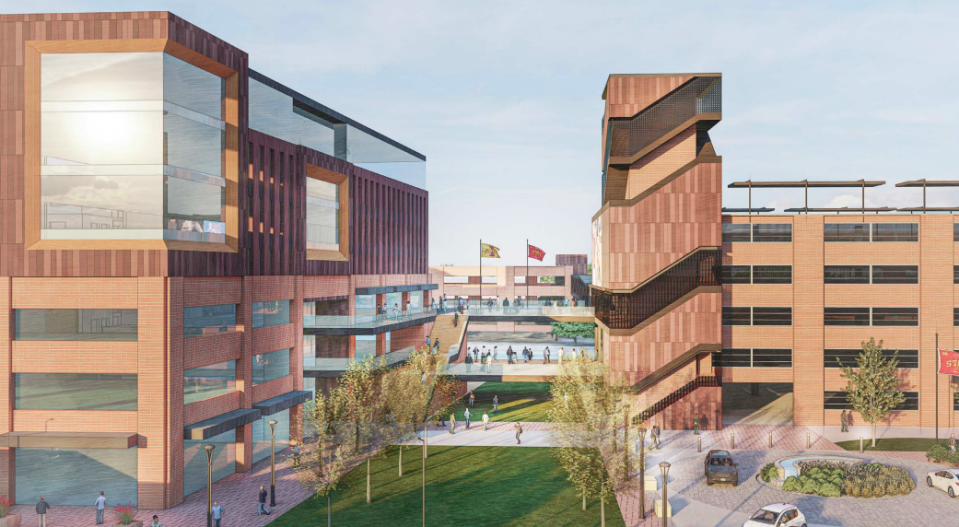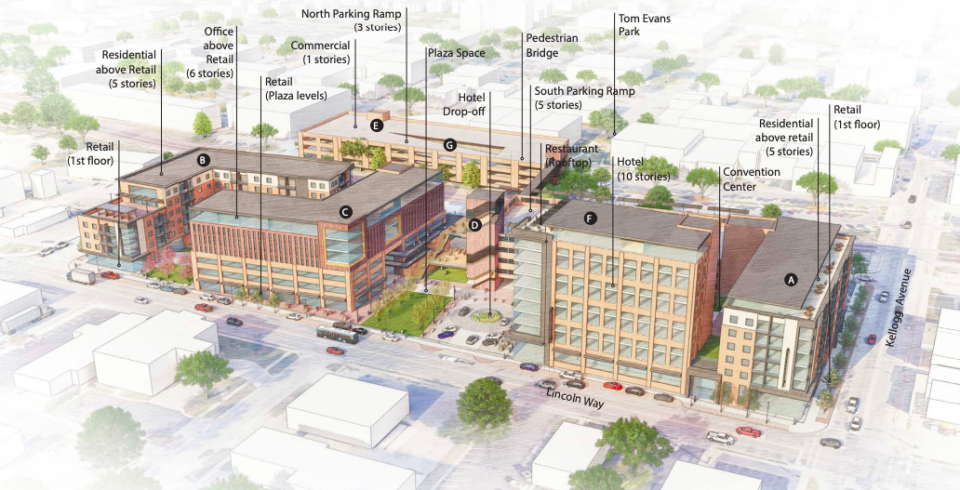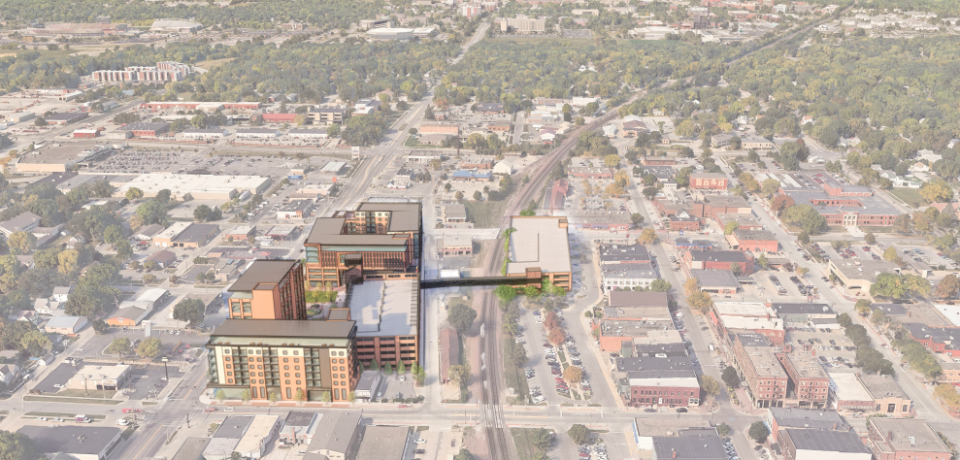Residents ask Ames to slow down on $42 million financial package for The Linc development
Ames City Council voted unanimously Tuesday night to move forward with a proposed development agreement between the city and developers Christensen Development of Des Moines and Hunziker & Associates of Ames to build The Linc.
Council directed staff to finalize the preliminary development agreement for a formal council vote in the coming weeks. Part of the agreement includes $42 million in tax increment financing, the highest incentive package ever offered by Ames.
The proposed $150 million development would be built on Lincoln Way between Clark and Kellogg avenues in downtown Ames and would include a 100-room hotel and conference center, hundreds of apartments, retail and commercial space, and a pedestrian bridge arching over the Union Pacific Corporation railroad tracks to Main Street.

Community tells Ames City Council to slow down
Three Ames residents asked the City Council to slow down to allow the public more time to understand the project.
Sue Ravenscroft read a letter from Merlin Pfannkuch, who said the project is too large, too dense and won’t fit in with the historic downtown. Pfannkuch said in his letter the project’s financial projections are undecipherable.
“So many things about The Linc seem a fantasy,” Pfannkuch wrote. “The project seems very risky.”
After reading Pfannkuch’s letter to the council, Ravenscroft echoed some of his comments.
More:Ames could commit $42 million to The Linc as more details on hotel, apartments are released
“I’m here asking you to take time to more fully inform people," Ravenscroft said. “Even people who have some knowledge of the construction plans tend to have very little understanding of the proposed TIFs (tax increment financing), which include a $42 million tax rebate, which amounts to 28% of the project’s price tag.”
Susie Petra stressed to the council that she supports The Linc because she supports the concept of high-density development. However, Petra said, a complete occupancy study is needed for the project.
“As is, the conceptual design currently offered puts the cart before the horse,” Petra said.
Petra also said the current plan calls for parallel parking along Lincoln Way, “the busiest thoroughfare in Ames.”
If parallel parking is allowed along this stretch of Lincoln Way, it would be the only area of the roadway east of Iowa Creek with on-street parking. Petra emphasized the need to better plan for the heavy traffic, pedestrians, bicycles and delivery trucks along Lincoln Way.
More:Ames City Council OKs $192M in projects included in final reinvestment district application
“To fully comprehend all the special problems this current proposal presents, council, as well as the public, would be best served if a 3D miniature model is requested,” Petra said.
Also Tuesday, Ames Chamber of Commerce President and CEO Dan Culhane, Discover Ames President and CEO Kevin Bourke, and Chuck Winkleblack with Hunziker & Associates urged support for the project.
During council discussion, City Council member Rachel Junck asked that the developers identify how many electric car charging stations will be included in the project, along with where they will be located.
How does tax increment financing work?

As an incentive to the developers, the city is offering tax increment financing for the project, which is expected to bring in an estimated $52.4 million in property tax revenue over 20 years.
The city would waive $42 million of that income from the developers' property taxes and keep $10 million to build a public parking structure on the north side of the railroad tracks near Main Street.
TIF districts divert property taxes created from increased property values in a small geographical district to subsidize development inside of the defined area, according to Good Jobs First, a national policy resource center based in Washington, D.C.
As the property values within the district increase because of new development, the additional revenue won’t go to schools, fire departments, roads or other city services. However, the property valuation before the new development starts, known as the base, would continue to be taxed and paid annually to all local and state taxing authorities.

The agreement would divert a maximum of $42 million to the developers over 20 years. It would expire when the maximum amount is paid, or when 20 years passes, whichever comes first.
Once that payment or time period passes, all additional property tax revenue would go into local and state coffers.
TIF districts are used in every state except Arizona. Iowa has the most TIF districts with 3,340, according to Good Jobs First. Minnesota has the second most districts with 1,719, followed by Texas with 1,378.
More:'Jack Trice broke barriers': New sculpture commemorating ISU player installed at stadium
“It’s not something I would recommend for a number of projects and it’s something that I don’t think is going to happen again,” said City Manager Steve Schainker. “But we try to offer extraordinary incentives when we deal with a catalyst project to help accomplish one of (council's) priorities.”
Schainker said the commercial space must have sales-tax generating businesses like restaurants and retail, but not offices.
“They have to have at least 70% of the space, at all times, leased to sales tax generating space,” Schainker said. “ … If they don’t meet that at any one time, we are writing into that contract they will be in default.”
What comes next with The Linc?
Developers said they can continue their design plans with Tuesday’s council vote to move forward to finalize the agreement. Plans are expected to change from the current working conceptual designs.
For example, developers don't yet know how tall the buildings will be. And they must secure agreements with Union Pacific Corp. and obtain private property easements before the pedestrian bridge to Main Street is designed.
Winkleblack told the council as the agreement is finalized and signed, more information can be released regarding which companies are committed to the project, including hoteliers, restaurants and retail outlets.
Teresa Kay Albertson covers crime, courts and local government in Ames and central Iowa for the Ames Tribune and Des Moines Register. Reach her at talbertson@registermedia.com or 515-419-6098.
This article originally appeared on Ames Tribune: Ames council asks staff to finalize The Linc development agreement

